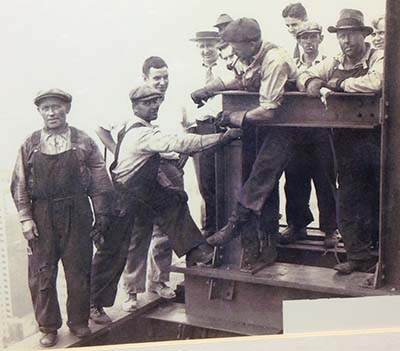GAI Sr. Project Engineer Todd Wilson, PE, MBA is a published author with a lifelong interest in Pittsburgh civil engineering and a surprising family connection to some of the city’s standout infrastructure achievements.
A Lifelong Passion Turned Fulfilling Career
In addition to producing the iron and steel that enabled railroads to cross the continent, bridges to span great distances, and landmark buildings to reach new heights, Pittsburgh and the surrounding region is itself a center of innovative civil engineering achievement.
I’m a Pittsburgh native, and I grew up fascinated by the city’s distinctive bridges, roads, and buildings. Today, I’m a Traffic Engineer at GAI, and I’m privileged to put my expertise to work to improve transportation infrastructure throughout western Pennsylvania and beyond.
And while my day-to-day responsibilities involve creating designs to keep traffic flowing and conducting transportation studies throughout my city and beyond, bridges have also been some of my favorite facets of Pittsburgh civil engineering since childhood—an interest no doubt fueled by the hundreds of inspiring spans throughout ‘The City of Bridges.’
That said, it may come as no surprise that this discussion of standout Pittsburgh area civil engineering accomplishments begins with the Three Sisters bridges, some of the city’s most noteworthy.
Pittsburgh Civil Engineering: The Three Sisters Bridges
The Three Sisters bridges are so named as they are nearly identical spans that cross the Allegheny River at Sixth, Seventh, and Ninth Streets. Deeply associated with the Pittsburgh experience, they’re named for local legends—baseball great Roberto Clemente, artist Andy Warhol, and environmentalist Rachel Carson.
![]()
Built between 1924 and 1928, the Three Sisters are the first examples of self-anchored suspension bridges in the United States. These bridges had to meet challenging specifications of both the War Department, which mandated that bridges provide long spans with ample clearance for river traffic at the high-water mark, and Pittsburgh’s Municipal Art Commission, which determined that three identical suspension bridges offered the best structural design to meet the organization’s aesthetic vision of preserving city views from the bridge decks.
The Three Sisters bridges epitomize the spirit of the City Beautiful movement, which held that public works could be of graceful, monumental design while providing practical function. Designed by the Allegheny Department of Public Works, built by the local American Bridge Company using Pittsburgh steel, and now painted the gold color distinctive to many of the city’s bridges, the Three Sisters are today well-loved Pittsburgh landmarks and beautifully expressed civil engineering achievements.
Pittsburgh Civil Engineering: The Pennsylvania Turnpike
There may be more eye-catching examples of civil engineering in and around Pittsburgh, but as a Traffic Engineer I can’t overstate the far-reaching vision and beneficial public impact of the Pennsylvania Turnpike. The Turnpike is America’s first long-distance, limited-access highway, and it became the model for America’s Interstate Highway System.
The Pennsylvania Turnpike opened to traffic in October 1940. It was built largely along the right-of-way of the failed South Pennsylvania Railroad, construction of which was abandoned due to business conflicts in the mid 1880’s. The original Turnpike route utilized seven tunnels though the Appalachian Mountains that were originally built for the railroad, and stretched 160 miles from US 30 in Irwin, PA, east of Pittsburgh, to US 11 in Carlisle, PA, west of Harrisburg.
![]()
The Pennsylvania Turnpike literally paved the way for safe, high-speed automobile travel in the United States, and today extends the full length of Pennsylvania from New Jersey to the Ohio border and includes several north/south extensions. Considered ‘America’s first superhighway,’ the Pennsylvania Turnpike today makes up part of Interstate 76, Interstate 276, and, as of September, the last link of Interstate 95. Great civil engineering milestones like the Pennsylvania Turnpike are never far from my mind as I contribute to transportation infrastructure projects as part of the GAI team.
Pittsburgh Civil Engineering—and Family Legacy: The Gulf Tower

I recently found out that the roots of my interest in civil engineering works may run even deeper than I could have predicted. Through genealogy research, I discovered that my own great-grandfather took part in building some of Pittsburgh’s distinctive structures. His name was Stephen Lander, and he immigrated to the Pittsburgh region from Canada in the late 1800s. While he passed away decades before I was born, the public records I’ve found tell the story: his marriage documents list his occupation as ‘Bridge Builder.’ Needless to say, I was thrilled to discover this family connection to Pittsburgh’s history of innovative building.
I can’t say with certainty what Pittsburgh bridges Stephen Lander worked on. But one surviving image tells us that he indeed had a hand in building a standout Pittsburgh structure—the signature Gulf Tower.
![]() A newspaper photo my father discovered shows my great-grandfather standing near the pinnacle of the yet-unfinished tower among a group of overall-clad workers. Defying the heights in a manner that would appall today’s safety specialists, Lander and his crew pose for the camera free of harnesses, hardhats, or protective scaffolding.
A newspaper photo my father discovered shows my great-grandfather standing near the pinnacle of the yet-unfinished tower among a group of overall-clad workers. Defying the heights in a manner that would appall today’s safety specialists, Lander and his crew pose for the camera free of harnesses, hardhats, or protective scaffolding.
Originally named the Gulf Building and built as the headquarters of the Gulf Oil Company, the tower features a distinctive crown modeled on the step pyramid design of the fabled Mausoleum of Halicarnassus. Built upon a skeleton of Pittsburgh steel, the 44-story, 582-foot Gulf Tower was the tallest building in the city at the time of its completion in 1932, a distinction that stood for nearly 40 years until surpassed by the U.S. Steel Tower in 1970.
The Gulf Tower was designed by architects Trowbridge & Livingston, engineered by the McClintic-Marshall Construction Company, and built by contractors Mellon-Stuart.
Carrying a Tradition Forward
These engineering highlights are just a few examples of many achievements that have established Pittsburgh as a center for innovative public works. As the city’s mighty steel industry recedes into history, Pittsburgh’s great civil engineering accomplishments are still important in helping usher in a new era of prosperity and growth. Pittsburgh’s bridges roads, buildings, and waterways today serve a burgeoning center for technology, healthcare, and higher education—and it’s gratifying to take part in helping improve my city’s infrastructure for coming generations.
As part of the GAI team and a member of the American Society of Civil Engineers (ASCE) Pittsburgh Section, I look forward to carrying the tradition of innovative Pittsburgh civil engineering into the future. And as the great-grandson of a man who helped shape some of Pittsburgh’s enduring public works, I look back with pride at a family contribution that helped build the city I love.
Contact Todd Wilson, 412.399.5299, for information about GAI’s traffic engineering and other civil engineering services.
Todd Wilson, PE, MBA, recently helped the American Society of Civil Engineers (ASCE) Pittsburgh Section mark its 100th anniversary as a publication facilitator and contributor to ASCE’s new book, Engineering Pittsburgh: A History of Roads, Rails, Canals Bridges & More. Wilson is also co-author of Pittsburgh’s Bridges.
Among his frequent speaking engagements, Todd recently served as a guest lecturer at University of Pittsburgh on the topic of Transit Oriented Development and led boat tours of civil engineering landmarks along Pittsburgh’s three rivers during during the 2018 Rail~Volution transit infrastructure conference and the ASCE International Conference on Transportation and Development. Todd will give a keynote presentation at the ASCE Pittsburgh Section’s Annual December Dinner on December 5, 2018.
![]() Todd Wilson, PE, MBA specializes in traffic-related civil engineering for transportation projects, and conducts various types of traffic studies and design plans, including traffic impact studies, safety audits, transit-oriented development projects, and parking studies. He performs traffic design and plan preparation for traffic control, signalization, signing, and pavement marking projects. Todd is active in numerous professional societies, including the Pittsburgh section of ASCE, for which he chairs the History & Heritage Committee.
Todd Wilson, PE, MBA specializes in traffic-related civil engineering for transportation projects, and conducts various types of traffic studies and design plans, including traffic impact studies, safety audits, transit-oriented development projects, and parking studies. He performs traffic design and plan preparation for traffic control, signalization, signing, and pavement marking projects. Todd is active in numerous professional societies, including the Pittsburgh section of ASCE, for which he chairs the History & Heritage Committee.


